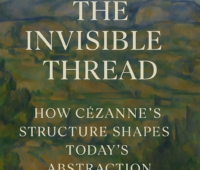
The Invisible Thread: How Cézanne’s Structure Shapes Today’s Abstraction
5 October 2025
Introduction: The Geometry Beneath Beauty
There’s a quiet force running through modern and contemporary painting—a kind of invisible thread that connects the sensuous apples of Paul Cézanne to the precise geometries of Piet Mondrian, the lyrical minimalism of Agnes Martin, and even the architectural abstractions of today’s painters.
Cézanne never claimed to invent abstraction. Yet, his radical rethinking of how form, color, and perception interact laid the foundation for almost everything that followed. For collectors and artists alike, understanding Cézanne’s enduring legacy means recognizing that modern art did not emerge from rebellion alone—it grew from structure, observation, and an obsession with truth.
As an art adviser, I’ve often said: the market celebrates revolutions, but it rewards continuity. Cézanne represents both.
Cézanne’s Structural Vision: Seeing with Logic and Emotion
Cézanne once said he wanted to “make of Impressionism something solid and durable, like the art of the museums.” He achieved this not by rejecting Impressionism’s love of light, but by rebuilding it—brick by brick—through geometry and logic.
In his still lifes and landscapes, color was not decoration; it was architecture. Look closely at his paintings of Mont Sainte-Victoire: planes of green and ochre build a mountain as if constructed from within. Each brushstroke carries weight, rhythm, and volume.
This approach—seeing nature as a series of interlocking shapes—changed everything. It shifted art from what we see to how we see. That is Cézanne’s real revolution: not the subject, but the structure of vision.
From Cézanne to Cubism: The Birth of Modern Form
When Picasso and Braque encountered Cézanne’s late works, they found permission to break the world apart. Cézanne’s geometrical simplification became the skeleton upon which Cubism was built.
Picasso famously called Cézanne “the father of us all,” and for good reason. Where Cézanne saw the cone, the sphere, and the cylinder in every apple and mountain, Cubism fragmented those forms into multiple viewpoints—turning structure into an intellectual exercise.
Cézanne’s insistence on the dialogue between volume and perception—between stability and movement—made possible the radical visual experiments that defined early 20th-century art. Without him, there would be no Cubism, and arguably, no abstraction as we know it.
The Minimalist Lineage: Cézanne’s Legacy in Abstraction
Cézanne’s structural clarity didn’t stop with Cubism. It seeped into every modernist movement that followed, often silently.
Mondrian distilled Cézanne’s planes into a rigorous grid, transforming the landscape into spiritual geometry. Agnes Martin carried that same structural calm into her meditative lines, translating Cézanne’s natural rhythm into quiet transcendence. Sean Scully and Ellsworth Kelly built on this lineage, finding emotional weight in repetition, color, and form.
Even today, in the studios of many contemporary abstractionists—from Sarah Crowner’s shaped canvases to Etel Adnan’s color-blocked horizons (a nod to Cézanne’s Mont Sainte-Victoire)—his influence persists. These artists share his instinct: that painting is not imitation, but construction.
Why Collectors Still Respond to Cézanne’s DNA
Collectors, often without realizing it, are drawn to works that carry Cézanne’s invisible discipline. In a market increasingly dominated by spectacle, there’s something reassuring—almost timeless—about structure, balance, and form.
Whether it’s the careful geometry of a Richter abstraction, the measured composition of a Riley painting, or the modular precision of a Judd sculpture, the appeal lies in a visual order that feels anchored. Cézanne’s legacy teaches that even in abstraction, authenticity emerges from restraint.
For serious collectors, this lineage offers a way to see beyond the surface of style—to trace the evolution of thought that connects Impressionist color to conceptual clarity.
The Market for Structural Clarity
The market reflects this quiet respect for Cézanne’s influence. Works that embody visual discipline—those that balance emotion with intellectual structure—tend to endure. Collectors who understand this principle are better positioned to identify long-term value.
Just as a Cézanne landscape holds its power century after century, so too do works by artists who approach form with a similar seriousness. Their prices may fluctuate, but their cultural gravity doesn’t.
In an era where overproduction and market-driven aesthetics often overshadow authenticity, Cézanne’s philosophy offers a guide: fewer gestures, deeper meaning.
Conclusion: The Artist Who Built Modern Vision
Cézanne didn’t paint for the market. He painted for the eye, the mind, and the future. His canvases are laboratories of perception—where sensation meets structure, and chaos finds form.
His influence lives not in imitation, but in inheritance. Every painter who balances emotion with geometry, intuition with logic, is part of his lineage. And every collector who seeks substance beneath surface beauty is, consciously or not, chasing the same timeless ideal.
Cézanne taught us that art’s true power lies in what endures—and what endures always begins with structure.
Daniel Turriani
